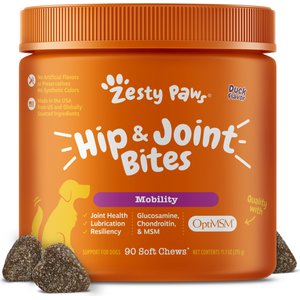Anyone who is or has been the pet parent of an older dog understands the dilemma of trying to determine when pain from common senior dog aliments, like arthritis or cancer, is bad enough to warrant medical treatment. In older dogs, arthritis of the hips, knees, shoulders and elbows is extremely common, as is lower back pain. Fortunately, there are a number of safe old dog pain relief options.
It’s important to weigh the risks and potential side effects when choosing a senior dog pain management option. But the first thing a pet parent needs to know is how to identify when a pet is in pain.
Signs Your Old Dog Is in Pain
So, how do you know if an old dog is in pain? The following signs can signal many different types of pain, and all of them mean you should consult your veterinarian.
- Squinting of eyes is a pretty dependable sign of pain, especially if accompanied by rapid breathing.
- A hunched posture is often associated with abdominal or back pain.
- Obsessive grooming, especially when it involves a particular area of the body, also signals pain. For example, if a dog is constantly licking the skin over a joint, there may be pain or inflammation in the joint.
- Difficulty sitting or rising is often the first sign a pet owner notices.
- Sometimes, the only obvious sign of pain may be that a dog who has always been friendly and tolerant suddenly becomes irritable or even aggressive.
Once you and your vet have established that your pet has pain that needs to be managed, you can discuss the possible pain relief options for old dogs.
5 Options for Senior Dog Pain Management
1Weight Loss
Obviously, weight loss is not a factor in controlling pain for dogs with cancer, but it is a significant factor for many overweight dogs with arthritis. Carrying around 25 percent more weight than a body was designed for can be very taxing to a sore hip or knee joints. Therefore, weight control is oftentimes one of the most important things you can do an old dog with arthritis pain or old dog with hip pain.
2Supplements (Nutraceuticals)
For chronic pain of osteoarthritis in dogs, there is good evidence that omega-3 fatty acids have a significant anti-inflammatory effect when given at relatively high doses. A 50-pound dog would need approximately 2,000 mg of fish oil daily to fill that need. The medical evidence for glucosamine, chondroitin and MSM is much thinner than that for omega-3s, but some studies show that they may help. Hyaluronic acid might be helpful as well, and injectable polysulfated glycosaminoglycan—known as Adequan—is easily absorbed and has been clinically proven over the years. All of these supplements are very safe when taken in the recommended doses, and even old dogs with poor kidney function can tolerate them well.
Certain kinds of dog food, both over-the-counter and prescription, contain glucosamine, omega-3s or other supplements, and can be very useful, but I recommend using only products that have been evaluated by Consumer Labs or a similar organization, and have been shown to contain the supplements and nutrients that they claim to.
Get a list of the best joint supplements, according to veterinarians.
3NSAIDs
Wondering what pain medicine you can give a dog, or if over-the-counter medicine is safe for dogs? Let’s begin with NSAIDs: Non-steroidal anti-inflammatory drugs are pharmaceuticals that are not corticosteroids (like prednisone) or opioids (like morphine or codeine). They can have different mechanisms of action, and, because of that, may have different levels of efficacy and safety in individual animals. This class of drugs includes carprofen, ketoprofen, meloxicam, aspirin, ibuprofen, naproxen and many others.
Aspirin is the only over-the-counter NSAID that is well-known to be safe, although its use in dogs is considered off-label. It’s always best to talk to your veterinarian before using it. Safer and more effective products than aspirin are available, so it should be used only as a temporary measure unless specifically recommended by your vet. If using aspirin, give only buffered aspirin, as the non-buffered form can cause significant stomach upset.
Prescription NSAIDs like carprofen and meloxicam have a very good safety and efficacy record. In my opinion, the risk of side effects is well worth the benefit. These drugs can give your arthritic pet a significant boost in quality of life with minimal risk.
Older dogs with potential liver or kidney problems may need periodic blood tests to use NSAIDs for prolonged periods. In sensitive dogs, NSAIDS can cause stomach upset or bleeding of the stomach lining, but these are not especially common side effects.
The most common problem I see with the use of NSAIDs is that owners are often afraid to use them daily as directed; they try to only use them when the dog’s pain becomes more apparent. Many of these drugs are designed to be used on a daily basis to prevent pain, rather than used reactively to treat pain after it’s already present. Because arthritis is not going to go away and be “cured,” NSAIDs will often work much better if used daily or as directed by your veterinarian.
Learn more about what you can give a dog for pain.
4Opioids
Due to their high abuse potential, drugs like oxycodone or hydrocodone for dogs are not usually prescribed, although they can be very effective. If your dog has intractable pain, the use of these drugs may be warranted, and you should ask your vet about hydrocodone for dogs, as well as other opioids.
There is only one opioid that is commonly used to treat chronic pain in dogs, and that is tramadol. By itself, it’s minimally effective for mild to moderate pain, but it works very well in combination with NSAIDs. It has a low dependence potential and is very safe. By combining NSAIDs with tramadol, you can also minimize the risk of side effects, because you can use the lowest possible dose of NSAIDs.
5Other Therapies for Old Dog Pain Relief
Although acupuncture and massage therapy may be helpful, there is not much evidence that they work very well as stand-alone treatments for chronic pain. I believe these should always be used in combination with other therapies.
Get tips on how to give a dog massage.
There are some exciting developments on the horizon, however. There are large clinical studies using stem cell therapy, which is showing great promise for canine arthritis. Gene therapy is being used experimentally right now, and only time will tell if it will prove to be helpful. Cannabis is also being examined, and extrapolations from human studies indicate it may be very effective in dogs. In fact, there is a medical cannabis product made specifically for dogs with cancer. If you want to consider its use, be sure to learn what the laws are in your state.
Take a Gradual Approach to Senior Dog Pain Management
My usual recommendation for older dogs with pain is to start small and add as needed. The first thing to do is to control weight. If that is not enough, you can start nutraceuticals such as fish oil, glucosamine and other supplements. If that still is not enough, you can discuss using NSAIDS, with or without tramadol, or other another pain medication for dogs with your veterinarian.
Of course, we have to consider side effects, but having seen first-hand the risk versus reward, there is no doubt that the overwhelming majority of old dogs with cancer or arthritis will have a much better quality of life with good senior dog pain management plan.
Share:












